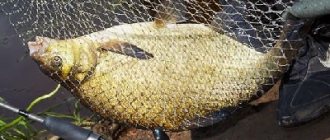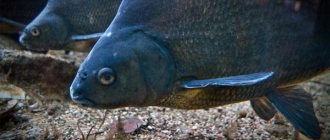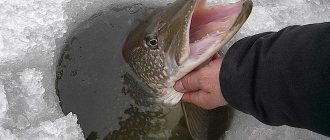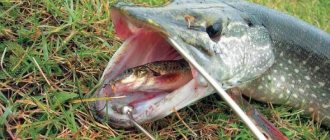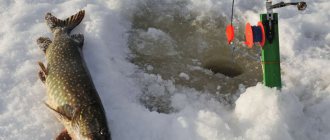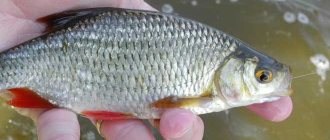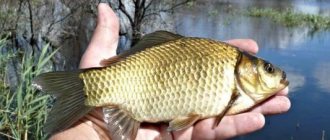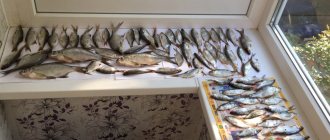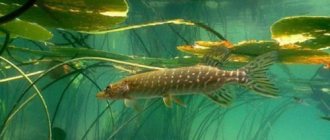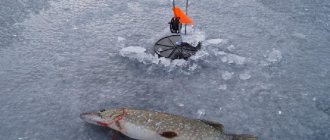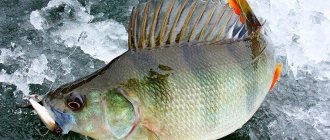Do you live in St. Petersburg, love fishing and have never been to the north of Ladoga? Life is passing you by, we urgently need to catch up!
The Ladoga skerries are one of the most impressive places we have ever fished. The Ladoga skerries are our main summer fishing spot; during the season (from May to October) we manage to get there on average 4-5 times (stories about fishing in the skerries here).
Lake Ladoga: description
Lake Ladoga is the largest among the lakes of Western Europe.
It is replenished by many rivers, with only one flowing out - the Neva. The bottom topography is heterogeneous, in the north there are a significant number of sharp changes, and the southern bottom is more even. The depth of the reservoir varies: in the north - 60-220 m, in the south - 15-70 m. The deepest place is located near the Valaam archipelago, the depth is 233 meters. The water area contains about five hundred islands. On any of the rocky islands that dot Lake Ladoga, fishing will be rich in trophies. Ice begins to cover the reservoir from the end of October and disappears completely at the end of April. The lake is rarely completely covered with ice, only during severe frosts, so in the central part there is often no ice. The weather is often windy and changeable. Calm may give way to a strong storm.
Where are the best places for fishing on Ladoga
More than 60 species of fish live in the Ladoga reservoir. An experienced fisherman can catch salmon: salmon, vendace, trout, palia. On Ladoga you can also find raw fish, roach, and ide. Other valuable fish: smelt, whitefish, grayling. The main fish for fishing is pike perch, its abode is shallow thickets in the southern part.
Of the elite fish in the northern waters, salmon predominates, but pali, Baltic sturgeon, and sterlet can also be found. Bream lovers can go to the southern part of the lake to get it. Whitefish can be found in seven forms: four lake and three lake-river. Everywhere you can catch small fish - vendace. A larger variety, the ripus, is found in southern waters.
Fishing is possible all year round, the main thing is to find cool fishing spots on Lake Ladoga. The water contains almost 100% dissolved oxygen, so there is no winter lull - this is a distinctive feature of the reservoir.
Features of fishing on Ladoga
Ladoga has a wayward character and capricious disposition. A large amount of precipitation and rough waters distinguish the lake. In the summer, Ladoga calms down for a short time, but then again tests those who decided to conquer it to their strength.
The diversity of the aquatic world of Lake Ladoga attracts anglers who love active recreation. Almost fifty species of fish can be observed in the waters of Ladoga. Some species were introduced artificially, some migrated from other waters, but the bulk of the lake’s ichthyofauna lives in its native element.
You can fish on Lake Ladoga all year round. Pike fishing on Ladoga has become especially successful. Fishing on the lake without an echo sounder is difficult. Those fishermen who have been plowing the spacious waters of Ladoga for many years can, by some of their characteristics, determine where the pike is standing. But still, besides using an echo sounder, there is an option on how to find predatory fish. This is fishing. You should not quickly leave the spot, it is important to move forward and constantly cast the spinning rod. Based on the fact that pike loves writhing, falling, and obstacles at the bottom, you need to look for a parking place for this predatory fish.
When using gear for pike, you should remember that the bottom of Lake Ladoga is grassy, which interferes with the work of baits, especially when trolling.
Since the shores of Ladoga are very diverse, there are free places for pike. Swampy islands, shallow meadows overgrown with vegetation such as horsetail and sedge. Alder and Willow lower their branches to the water, covering predators from the light. Why not challenge the fisherman?
Note to the fisherman! Tips from experienced fishermen: the first foray into a reservoir to catch pike can be as early as early March, before the spawning period. The next two months will also be cool. It is known that pike activity occurs during the hunting season. In the morning or evening, the predator goes out to get food and can become prey itself. At other times, the pike hides in thickets or pools.
Popular fishing spots on Lake Ladoga
Zagubskaya Bay is the warmest place on Ladoga. In summer, the water temperature reaches +20 degrees, sometimes +25. It begins to freeze in December, the ice thickness reaches 60 cm. In the waters of the bay it is good to catch pike with girders. It is difficult to catch fry, so you need to prepare them in advance. Popular catch: perch, bream, pike, roach.
| Staraya Ladoga Canal - fishing | |
| Fishing in the Staraya Ladoga Canal is popular, but complicated by inconvenient access roads. The dry canal was no longer used for navigation, it was overgrown with thickets, and in some places fortifications had collapsed, making it difficult to fish from the shore. For fishing, it is better to use a boat, preferably with a motor. The trophy can be pike perch, pike, ide, ruffe, crucian carp, roach. For fishing, use a float rod or spinning rod. | |
| Novoladozhsky Canal - fishing | |
| Anglers from all over the region love to fish on the Novoladozhsky Canal. Thanks to the good bite and the ability to drive to the shore by car, both experienced fishermen and those who like to relax with a fishing rod like to come here. You can catch a wide variety of fish in the canal: roach, bream, pike perch. The usual trophy is perch, you can catch crucian carp, pike, and pike perch. Large fish are rarely caught. Winter fishing is popular on the canal; perch and pike bite during this period. | |
| Skerries of Lake Ladoga | |
| Skerries are small islands with a rocky landscape. There are numerous places for fishing on Lake Ladoga, but skerries attract anglers with shallow backwaters and small coves. You can get to the islands by land only in winter; in summer you can get there by boat. In the shallow waters there are bream, perches, and roaches. You can catch pike in the reed thickets. In the depths it is possible to catch burbot, pike perch, perch, vendace, and rarely elite varieties. | |
| Zagubskaya Guba - fishing | |
| Depth maps of Lake Ladoga 2015 | |
| If you wish, to explore the best places for fishing, you can open a map of Lake Ladoga. This is an updated version of the map, on which all depths and access roads are marked. Having studied Lake Ladoga, places for fishing in winter and summer can be found, focusing on the depth where a certain type of fish can be found. | |
Fishing on Lake Ladoga
Fishing on Ladoga and the rivers flowing into it is very rich. Moreover, the composition of the catch depends on a specific place, and these places are well known to fishermen. So, for salmon they go first of all to Svir, for trout - to the rivers of Northern Ladoga, the main spawning grounds of palya are located near the Valaam Islands and to the west of them, for vendace during the feeding period - to the eastern shore, north of Svirskaya Bay, most of the grayling are in the rocky shores of the northern shore of the lake, asp and bream are found in the southern part of the lake. But an eel can be caught on a hook anywhere in the lake and on the rivers flowing from it - however, only to an experienced and lucky fisherman.
The largest in Europe
Lake Ladoga is the largest freshwater lake in Europe and the eighth deepest among Russian lakes. Its basin, originally of tectonic origin, was finally formed under the influence of Quaternary glaciers. The northern and southern parts of the lake differ significantly from each other. The northern shores - from Priozersk in the west and Pitkäranta in the east - are high, rocky, deeply cut by fjord-like bays, covered with forest. Most of the islands forming the skerries are concentrated here. The southern shores look completely different: low, slightly indented, covered with willow and alder, with numerous sandy and boulder beaches. There are often shoals, rocky reefs and banks here. In some places on the southern coast there are ancient coastal ramparts covered with pine trees.
Countless Islands
There are countless islands on Lake Ladoga; they occupy more than 2.5% of its area. Among them there are both very large and very tiny. There are more than 650 large islands alone, whose area exceeds one hectare, on Ladoga, the bulk of them - about half a thousand - are located in the northwestern part of the lake, in the so-called skerry area. Many islands rise 60-70 m above the water level, striking the imagination with the bizarre contours of their rocky shores. The largest islands are Riekkalansari, Mantsinsari (which gave its name to a group of 40 islands), Kilpola, Tulolansari, and Valaam (part of the archipelago of the same name, which includes about 50 islands). The Western archipelago, which includes groups of islands stretching for 15 km, has the status of a specially protected natural area (fishing is allowed in the reserve).
Many bays
Almost half the length of the coastline of Lake Ladoga falls on the skerry area - such is the degree of ruggedness of the northern coast. Numerous bays with narrow tongues cut deeply, sometimes more than 10 km, into the mainland coast. The largest bays are Lekhmalahti, Naismeri, Kurkiyoksky, Yakimvarsky, Sortavala. On the eastern shore there are only two large bays - Lunkulanlahti and Uksunlahti; next to them, as if separating them from the lake, is one of the largest islands of Ladoga - Mantsinsari. In the southern part of the lake there are three large bays; unlike others, they are called not bays, but lips: Svirskaya, Volkhovskaya and Shlisselburgskaya bays.
Rivers: about forty flow in, one flows out
Four dozen rivers flow into the huge lake, all of them are very different, but together they form a huge lake-river system. The largest, several hundred kilometers long, connect Lake Ladoga with other large lakes: the deep Svir - with Onega, Volkhov - with Lake Ilmen, Vuoksa - with the Finnish Lake Saimaa, where its source lies, and with several other lakes with which it forms a lake-river system on the way to Ladoga. The remaining rivers flowing into the lake are very small, short, sometimes no more than 20 km. Lake Ladoga is fed for the most part by inflowing rivers (85%).
The only river flowing out of Ladoga is the Neva, connecting the lake with the Gulf of Finland of the Baltic Sea and, accordingly, with the Atlantic, from where eel larvae appear. Eels come to the Baltic Sea and the Gulf of Finland already grown to 20-25 cm. From here they disperse into all the rivers flowing into the gulf. Through the Neva, eels enter Lake Ladoga, and from there into the rivers flowing into it.
Lake Ladoga: cool places for fishing in winter and summer
Winter fishing in the reservoir is as popular as summer fishing, but has specific features. It is more dangerous, since strong storm winds blow in winter, it can tear off the solder, and huge ice breaks into small pieces of ice in squally winds.
Winters are rare when Ladoga freezes completely; usually the middle is free of ice. Along the perimeter from the shore, the water freezes to great depths, forming strong ice at a distance of 10-15 km. Successful fishing is possible close to the shore, but you can drive several kilometers inland by snowmobile or car. When Lake Ladoga freezes, fishing continues on the ice shell through cut holes.
In winter, perch and roach live at a depth of 3–6 m, so for winter fishing you can choose places close to the shore, where you can walk. Anglers catch pike in reed beds in shallow water. The most exciting winter fishing for perch is a vertical spoon with a hook, soldered or hanging on a chain.
In the spring, the fish spawn and swim closer to the shores. They begin to catch roach even with floating ice floes in shallow reed beds, using a float rod. Bream and silver bream will spawn next, but the specimens are small and less interesting for fishermen. Real fishing begins with the spawning of hungry pike. It is best to catch the predator in the reed thickets of the southern part of Ladoga.
On white nights it is interesting to catch pike perch. For those who love trolling and go on boats along the shores at a distance of 3 to 10 km, rocky fishing spots on Lake Ladoga are suitable. Pike perch is active, so to catch it they use several spinning rods with wobblers of different depths.
In summer, fishing is good for perch, which begin to feed on fry. You can spot a school of fish by a cluster of seagulls. If you manage to find a flock, then a rich trophy is guaranteed. Small perch are caught using a spinning rod, while larger specimens are caught by trolling. Large fish stay away from the shore in summer, so you should use a boat for fishing.
catchable places
Lake Ladoga is covered with many islands, and almost half of the entire body of water is indented by bays. There are a huge number of places for fishing on the lake, and the variety of fish that lives here will not leave any fisherman, even a very experienced one, indifferent.
Each species of fish lives only in a certain place of Ladoga, therefore, when going fishing, you need to know in which part of the lake you can catch this or that individual. Smelt is found in almost any part of the lake, with the exception of the central one. But, for example, in the northwestern part of the reservoir you can catch burbot or grayling.
One of the most popular and catching places is the Novoladozhsky Canal, which is located 40 kilometers from St. Petersburg. The bite here is always good, the access roads are also excellent, so a lot of fishing enthusiasts gather here.
Winter fishing is very popular in the village of Lednevo.
The most successful place for catching predatory fish, such as perch or pike, is the mouth of the Kobona River.
A place rich in roach, pike, and perch is the village of Krenitsa, where the Volkhovets River flows into Lake Ladoga. The area is very popular not only among local residents, but also far beyond the Leningrad region, since the catches here are truly always impressive.
There are many skerries on Lake Ladoga - these are small rocky islands that surprise with their beauty. You can only get to them by water by boat or speedboat. There are a lot of fish in these places, so the skerry is one of the best places for fishing.
Brief history of Lake Ladoga
Lake Ladoga is the largest freshwater body of water in Europe, located in the Leningrad region and the Republic of Karelia. The total area of Ladoga is 17,890 square kilometers. The western, southern and southeastern shores of the reservoir are quite flat; they are covered with water meadows, marshy areas, forests, as well as fields where agricultural products are grown. This almost flat part of the lake belongs to the Leningrad region. In the Republic of Karelia, in the northern and eastern parts of the lake, the relief of the coastal zone of Ladoga changes dramatically. The coastline is represented by granite cliffs and cliffs, separated by narrow straits and bays, which the local population here calls skerries and fjords. This coastal part of the reservoir vaguely resembles the shores of Norway. At the tops of steep and rocky cliffs, a forest belt begins, covered mainly with coniferous forests. The lake forms three bays: Svirskaya, Volkhovskaya and Shlisselburgskaya. Many secrets and legends are attributed to Lake Ladoga. The most famous of them tells the story of the Swedish sailor-warlock Sigvard on a rusty schooner that disappeared on a stormy summer night in 1939. Since then, the ghost ship often and suddenly appears from the mystical fog in front of modern ships. A meeting with the Ladoga “Flying Dutchman” does not bode well for fishermen. Since the lake belongs to the basins of the Baltic Sea and the Atlantic Ocean, Ladoga is characterized by rapid changes in weather conditions. The maximum depth of Lake Ladoga is 324 meters. Average lake depths range in the southern part of the reservoir between 30 and 70 meters, and in the north from 60 to 230 meters. The length of Ladoga from north to south actually reaches 220 km, and its greatest width is almost 140 km. The reservoir near the shores begins to become covered with ice from the end of October and completely melts by the end of April. The entire lake freezes only during severe frosts. Most often, its middle is without ice cover. In stormy and windy weather, waves rise on the lake, the maximum height of which can reach 5.5 meters in height. But no matter what horror stories are attributed to Lake Ladoga, the interest of fishermen in this body of water does not disappear day or night. Nature has created here the most optimal conditions for recreation and rich fishing. Ichthyofauna of the reservoir
Ichthyofauna
Lake Ladoga is quite diverse. About 60 species of fish live here. Due to its size and geographical location, it is an excellent place for the existence of both sedentary and migratory fish species. Some fish can grow to significant sizes. Among the main species, it is worth highlighting the following: pike perch, pike, trout, salmon, asp, catfish, bream, palia, whitefish, rudd, roach, burbot, eel, vendace, smelt, perch, raw fish, silver bream, bluefish.
Lake Ladoga amazes not only with its picturesque coastal landscapes, but also with its varied underwater terrain, which creates excellent conditions for fishing. In the shallower, southern part, fishing for permanently living fish species is especially interesting. Here, among the vast expanses of aquatic vegetation, juveniles of various fish accumulate. Therefore, in the “lake jungle” there are a large number of predators robbing. The pike perch is especially worth highlighting; its size can surprise many experienced fishermen. In addition to a large number of common species, Lake Ladoga is home to rare, protected species: Ladoga salmon, brown trout, Volkhov whitefish, Atlantic sturgeon and some others; fishing for such fish is prohibited or regulated by rules.
Features of recreation and fishing on Lake Ladoga
Good transport infrastructure, many tourist and fishing bases, and private campsites attract a large number of vacationers. The vastness of the lake allows fishermen and vacationers of different abilities and preferences to successfully spend time. At the bases, at your request, you will be provided with a variety of water transport and safety equipment, ranging from a small rowing boat to a powerful boat equipped for trolling fishing, in which you can easily survive any bad weather. Base employees will advise on fishing specifics and help in organizing fishing. It is worth noting that on the shore there are wonderful places for family and friends to relax. Just look at the magnificent Ladoga landscapes. You can fish on the lake using any amateur methods: spinning, fly fishing, bottom and float rods, trolling, “circles” and so on. You can relax and fish in almost all seasons. Many people will be interested in winter types of fishing. It is worth noting fishing for migratory fish species, for example: vendace and smelt. The time spent doing this activity will please any fisherman. But we must take into account that there are restrictions on the number of fish caught and their size. Before your trip, check the rules of recreational fishing. It is important to know the species prohibited from fishing. In conclusion, it is worth noting that when taking long walks along a pond, it is advisable to have waterproof and warm clothes; this will not “lubricate the delight” of fishing due to the capricious nature of Karelia and the Leningrad region.
Fishing on Lake Ladoga
Finally, I went fishing for the first time in September. I was busy all weekend in September and couldn't get out. We planned to go fishing with Borya to the Gulf of Finland. According to the plan, we were supposed to leave on Friday straight from work. On Thursday I already loaded all my things into the car and was ready to leave on Friday.
Borya called before lunch and said that he would not be able to go in the evening. I called everyone I knew, but I still couldn’t find a partner. Yuri Sergeevich (Lempaa) offered to go with him to Vuoksa, but without a motor I didn’t want to go there. In the end, I decided to go alone, but not to the Gulf of Finland, but to Lake Ladoga in Lednevo.
I arrived at the place before dark, pumped up the boat and quickly took to the water. Swim across the canal, dragged the boat and here it is Ladoga. The weather was excellent, completely calm on Ladoga.
I rowed 600-700 meters from the shore and anchored. I mixed the bait and cast a float rod in the hope of catching a Ladoga roach. Well, from experience, perch is also good to catch on a float in these parts. While the float stood beautifully on the water surface, I assembled two spinning rods so as not to redo the tackle when changing baits. One was equipped with an edible twister with a Cheburashka, just like I catch perch in the Gulf of Finland, and on the other I put a wobbler.
In two hours I didn’t see more than one bite on a float rod. I tried changing the depth, changing attachments: worm, maggot and everything together (sandwich) to no avail. I changed my place a couple of times, swimming 200-300 meters to the sides. All the time, looking at the float, I trained with a spinning rod, but the result was about the same. There were two or three pokes on the rubber and that’s it, but there was a bite on the wobbler, but it disappeared immediately. It looks like a small pike.
Unique body of water
Ladoga, with an area of more than 18 thousand square kilometers, is the largest freshwater lake in Europe; it is fed by more than 35 rivers. When you look at the endless expanses of water, you cannot dare to call a body of water a lake - it’s just a real sea. And the depth is impressive: the average in the northern part is 70 m, and the maximum, near the Valaam archipelago - 260 m (some sources indicate 233 m). The water here is clear, with a small amount of minerals dissolved in it. The bottom is covered with silty sediments of predominantly organic origin; in the southern shallow areas the bottom is lined with sand and stones. There are countless islands and islets scattered around the lake, and in the south there are three most picturesque bays - Shlisselburgskaya, Svirskaya and Volkhovskaya bays. Those who come here for a traditional men's vacation - fishing - will not be left indifferent by the pristine beauty of the rocks, the pine wilds on the shore, untouched by human hands. This place is unique, and as if nature itself was created specifically for fishing. It is quiet and uncrowded here - exactly what you need. At the same time, this does not mean that you will have to spend your nights without comfort: there are fishing bases, campsites, and guest houses on the shores of Ladoga.
Cool fishing
Fishermen to Ladoga are attracted by hopes of an excellent catch, and it must be said that the expectations of those who decide to spend time hunting for fish are always justified. The only thing is that you need to immediately choose what kind of fish you want to get and select the appropriate gear, because Ladoga is characterized by a zonal distribution: some species can be found only in the warmer, shallow southern part of the lake, others live in the cold waters near the northern islands. The species composition is diverse, there are about 60 different species of fish in the lake, the vast majority of which are “local”. The rest come to the fresh water body from the Neva and its tributaries, from the Gulf of Finland. There are even seals here! In general, the following features can be noted for the lake: in its central part, starting from a depth of 40 meters and deeper, only isolated representatives of the ichthyofauna are found. Smelt is ubiquitous (with the exception of the indicated central regions); in the south it grows to a larger size than in the north of the lake. The shallow southern part is generally richer in fish than the skerry northern part. The main commercial fish is pike perch; 8-10 kilogram specimens are found here. The lake contains carp, peled, ripus, vendace, and taimen - as they say, there is something for every taste. But the sterlet, unfortunately, disappeared. Moreover, it is rare to see sea sturgeon, which is distinguished by its gigantic size. Sturgeon spawns in the tributaries of Ladoga.
The most valuable are:
- salmon (fishing is prohibited in order to restore the population);
- trout (fishing prohibited);
- whitefish;
- zander;
- bream.
Also found in large quantities in the lake are:
- pike;
- perch;
- roach;
- ruff.
Fishing continues throughout the year, without interruption for the winter. In most inland waters there is no such luck for the fisherman, but here the oxygen content in the water is extremely high, and therefore ice fishing for fish gives tangible results. When going fishing, you must carefully check the watercraft, equipment, and also take into account weather conditions. Ladoga is known for its tough temper: the water element often brings surprises to lovers of active recreation, and terrible storms have caused more than one tragedy.
Where can you go fishing?
On Ladoga they fish both in winter, from the ice, and in summer, from the shore and from a boat. In addition to traditional fishing, there is the opportunity to go underwater fishing. Fishermen mainly prefer the southern, shallow part of the lake, where most of the heat-loving underwater inhabitants of Ladoga are concentrated. In the north-west there is a high probability of catching grayling or burbot, and quite a lot of them. Due to the anthropogenic impact on the reservoir, the number of fish, especially valuable ones, is decreasing, but even in our time, fish in Lake Ladoga often reach heroic sizes. In general, you can fish almost anywhere - it’s just that each subspecies of fish is found in one or another part of the lake in greater or lesser quantities. To plan your fishing trip, it will be useful to learn about seasonal fish migrations. Fishing in this way will be successful in any case, but what awaits the fish hunter - piece catches, or bites following one after another? Good catches are more or less constant in some places, and therefore a few of the most catchy areas are the most popular.
Rating of catchable places:
- The village of Koshkino, Leningrad region, is located at the mouth of the Chernaya River. Here, anglers can expect pike and perch (for which, of course, you need to take a spinning rod), roach and burbot;
- the village of Krenitsy is located in the place where the Volkhovets River flows into Ladoga. Bream and roach, perch and pike are caught in Krenice with fishing rods and spinning rods, as well as by trolling. Due to its rich catches, this place is widely known far beyond the Leningrad region;
- the village of Nazia is located at the intersection of the river of the same name and the Ladoga Canal. This area is attractive to anglers due to the abundance of perch and pike;
- the village of Lednevo on Chernaya Satam is an extremely popular place for fishing, especially in winter. The bite is observed with jigs and spinners. Large bream and vendace are frequent guests in this place; at shallow depths there are many toothy predators - pikes;
- the village of Kobona occupies the mouth of the river of the same name. Successful winter fishing by local and visiting anglers allows us to place Kobona in fifth place in our ranking. A school of perch under the ice is a desirable catch for any fisherman. However, in the summer perch also invariably bites here: there are small specimens near the shore, and larger ones near the Zelentsy Islands (from a motor boat). Trolling for pike and pike perch is also successful.
Fishing reports 2021
During these holidays, I managed to almost completely realize my insidious plans to hide from my family for half the days to go fishing.
And the best part is that these were completely different bodies of water, different conditions, which once again made it clear that perch is an absolutely incomprehensible crap that can at any moment deny you the past experience and make you think, learn, analyze again... Well and of course, fuck him tomorrow who knows where from the place where you fucked him just today.
01/01/2021. The wonderfully sober New Year gave me the opportunity to go with Kostya Stepan73 to Ladoga, to Nazia. Sorry, a little blurry, while running.
Okushka was found in a dump, but it was small. Caught in waves, sometimes up to 10-15 in a queue. Swung on CT, caught on maralistic and Witch. It’s fun to watch them at a meter depth, you can clearly see this whole cheerful kindergarten.
Forgotten, already under Kostin’s menacing shout “Don’t wave!” attracted penguins. Here they are - robots in chemical protection with dull knives and a stuck cigarette. But they were surprisingly polite, they didn’t drill closer than 10 meters. Then the bite died down, but Kostya found another speck a little further into the lake, in the grass, and at least they were all the same size, about 100 grams. Maximum – 245 and 270 gr.
I also gave a series of 15 pieces, it was about 15 hours. Then it was cut off, and it was already sunset. Of the spinners, I really liked the Witch, it’s clear from the rebound and pause what she’s doing there.
Super, I've been dreaming about this for a long time - great weather, thin ice, good company, biting... It's a thrill.
04.01. Novogorodskaya, swamps. First the perch, then the gizzards. I walked with the thought - well, I’ll quickly catch a perch and put up some jigs...
And here’s where the horseradish comes in. 5, 10, 15 holes - silence. Everything - the maralists, the witch, the nails, the marapedki - everything was silent. I found a torpedo, and then it took off. Series of 4-6 pieces per hole, at a depth of 40-50 cm. This is simply fantastic for this place. I remembered all the perch sites from previous years, ran through them, then through all the possible calculated sites - he was biting. Mostly around reeds, on dumps in ditches.
I applied the whole theory of Petrovich and athletes. Buildup, 30-60 seconds - and the series began. I liked catching with small side swings, like in Petrovich’s recent video. Fucking fun. The total is under fifty dollars, but all live bait+ size.
There were no boars this time))),
and the female workers almost never work there after noon. But the sporting pleasure was received. But the reason for the bite only on the torpedo has not been revealed (previously, the maralist worked best).
05.01. Ilmen. With a Novgorod partner we went to Arkadskie from Navaloka. They poked and poked for a long time. First we tried it at depth, looking for a stall, rolling back and forth. Wasted. People also wandered aimlessly through the space. Then they joined a small crowd, where they occasionally dragged along on the meter. Well, classic, now I’ll push it. Yeah, right now. The entire Ladoga arsenal, then sports, then balances. Bitch, they drag me around, and I don’t even get a poke! What the hell?? Then the partner starts dragging - For what? - Ski. Yeah, I bet – scratch, scratch, scratch! And the perch is not bad, larger and smoother than in Nazia, 150+. No photo, unfortunately. Several offensive landings, and I barely tore one off the bottom - and went down in the hole. The itching went away, I put the leaf pads on again - quietly. So understand him.
Well, on 07.01 we flew completely over again in Nazia, both for perch and for girders. Caviar with eyes does not count, although there was a lot of it. But it’s really 5-7 grams... It was a really bad day, Krishna reminded me about the yin-yang - I returned to the car 2 times, a fucking slotted spoon was stolen, a friend drowned another fishing rod, he lost his fishing rod on the way back (well, at least he found it) . But we finally checked the tent – it’s awesome, I recommend it.
Moreover, on the same day, Kostya, Denis, and Alexey Udacha were there - but they found it. Unfortunately, we were unlucky.
About unlicensed fishing
Legends are made about the trophies obtained on Ladoga. But, unfortunately, most of these stories are from the distant past. At present, the populations of some fish species are yet to be restored, first of all, this concerns salmon. The fishing rules for the Western Fishery Basin determine fishing bans in Lake Ladoga and the river basins flowing into it, which are valid at certain times: “in permitted areas and time periods.” That is, the ban applies, for example, during spawning. In Lake Ladoga, the use of nets and electric current for catching fish is strictly prohibited. The sport fishing method - trolling - is allowed with certain reservations. All these prohibitions and restrictions should not be overlooked when choosing gear.
The best vacation on Ladoga is fishing in “cool” places
a holiday on Ladoga differently than a traveler-photographer or kayaker. But they all can’t even imagine how exciting and exciting a trip to Lake Ladoga can be for an avid fisherman! After all, the pros:
- Knows the best summer and winter places.
- Understands why the catch chooses different locations in different seasons.
- Intuitively senses whether there will be a bite or not.
If you want to get an adrenaline rush while on vacation in Ladoga, get ready for fishing! We will tell you where the bite is best and what kind of fish you can catch on Lake Ladoga
- The best places for fishing on Ladoga by cardinal directions
- Popular fishing spots on Lake Ladoga
- 100% proven places for fishing: holidays on Ladoga
- The system already selects the ideal option for your vacation.
- Please leave us your phone number.
- Our specialist will contact you soon and tell you about the details of the best tour selected for you.
How to catch pike on Ladoga
It is known that the Ladoga coastal zones are overgrown, and the sides are varied in bottom topography and shore. Knowing the habits of the pike species, the angler will, first of all, determine the nature of the bottom and fish the proposed fishing spots. Almost any gear can be used to hunt this predator. A float rod, spinning rod, and bottom tackle are quite suitable for catching pike on Ladoga.
Read more:
Fishing for grass carp
It is important to remember some little things. A fishing rod should have a tight end. But as for the float, it should be the size of an egg, and possibly of a similar shape. Hooks, a sinker and a metal leader complete the necessary equipment. The length of the fishing rod can be short or medium, with guides, a reel and a sliding float.
When fishing for pike on Lake Ladoga with a spinning rod, it would be advisable to use a spoon. It turned out experimentally that if you tie several threads of different colors to a treble hook, the fish will bite better. Pike probably like interesting baits. It is advisable to take colored wobblers and poppers for hunting predatory fish.
By attracting the attention of a predator, you can count on a possible bite. In summer, fishing begins in the early morning; in autumn, pike are hooked throughout the day.
Holidays with fishing on Ladoga: the best places for fishing on the cardinal points
In order for an active holiday on Lake Ladoga to be a success, and for fishermen to return home with full cages and not with disappointment, you just need to know what kind of fish is found in which part of the lake.
- North. The northern part of Lake Ladoga is loved by elite and rare fish species. Here you can catch sturgeon, palia, and sterlet.
- South. In the south, bream, pike perch, pike, perch, and salmon are found on dense shallow ground. It cannot be said that you will not find, for example, sterlet in the southern skerries. We are talking specifically about a happy “cool” hunt, and not a single bite.
- Northwest. Large grayling and burbot prefer the northwestern regions of the reservoir.
Knowing the preferences of fish of different breeds and understanding their migration system, we can say with a high degree of probability that a fishing tour to Ladoga will end in success.
The best places for fishing in Karelia in summer
We offer a list of the most fishing places on Lake Ladoga:
- The village of Koshkino (the mouth of the Chernaya River). Found: roach, perch, burbot, pike.
- Village of Nazia (river of the same name). Found: pike and perch.
- The village of Krenitsy (where Volkhovets flows into the lake). Found: perch, bream, pike, roach.
- Village of Kobona (river of the same name). Found: pike perch, perch, pike.
- The village of Lednevo (Chernaya Satama Bay). Found: pike, vendace, bream.
Lake Ladoga itself can be divided into three areas according to the habitats of different species of fish:
- South, here are the coolest places. There are a lot of fish and a wide variety of fish. True, you won’t find rare species.
- North, this is where you can catch elite fish, for example, trout.
- North-West, if you need large grayling and burbot, then you need to go to this part of the reservoir.
Active recreation on Ladoga: the best places for fishing
Avid fishermen know the best places to relax on Ladoga. Well, that is, they take their family with them to guard the base camp, and they themselves go to “cool” locations. The most popular for fishing fans are:
- Staraya Ladoga Canal.
- Novoladozhsky Canal.
- Skerries of Lake Ladoga.
- Zagubskaya lip.
Staraya Ladoga Canal
The Staraya Ladoga (aka Petrovsky, aka Ladoga) canal has not been used for shipping for a long time, so its banks are overgrown with bushes, and the fortifications have collapsed. Fishing from the shore is difficult here, and the access roads are very inconvenient. For these reasons, fishermen prefer to go for trophies by boat, many by motor boat. Active recreation on Ladoga in combination with fishing can bring its “fruits” in the form of:
The most common gear used is a spinning rod and a fishing rod. Staraya Ladoga is not only a fishing spot on the Volkhov River, but also a famous tourist destination.
Novoladozhsky Canal
The Novoladozhsky Canal connects the Neva and Svir. Its length is 169 km, and Ladoga is only 500 m away. The depth of the canal is “regulated” by the water level in Lake Ladoga, and can be one and a half meters (1.6 m in 2012 - a record low!) and 2.5 m. The canal is connected to the lake by many channels, and its width varies from 40 to 60 m. Fishing enthusiasts and “lazy” tourists come to relax on Ladoga: sunbathe and swim. In these places there are well-rolled roads and therefore you can drive to the shore by car. From St. Petersburg to the Novoladozhsky Canal is only 43 km. That is why St. Petersburg fishermen go here on weekends to catch their catch. Winter fishing is popular: perch and pike are popular at this time.
Skerries of Lake Ladoga
The rocky landscape of the skerries of Lake Ladoga attracts fishermen with shallow creeks and compact bays. In the warm season, fishing and recreation on Ladoga in the skerries can only be reached by water - by boat or motorboat. But in winter they come to the islands on ice. Caught here:
- Roach.
- Perches.
- Podleshchikov.
- At great depths - burbot and pike perch.
- In the thickets near the banks - pike.
- Sometimes in the skerries it ends with a truly royal gift: elite varieties of fish - sea salmon and sturgeon.
Zagubskaya Bay
Zagubye or Zagubskaya Bay is a bay of the Svir River. Great place for fishing:
Due to the terrain, the water here can warm up to 25 degrees in summer. Therefore, not only fishermen, but also ordinary townspeople come to relax on Ladoga in Zagubye, hoping to have a good weekend, swim and lie on the sunny shore. Miners in Zagubskaya Bay catch pike with girders. It’s “tight” with the fry here, so they are prepared in advance.
We wish you a pleasant stay, no matter where you choose!
Active recreation on Ladoga and the best places for fishing
For productive fishing, it is necessary to study promising areas. A large concentration of inhabitants of the depths is observed in places with complex terrain, vegetation, sandy or rocky bottom.
Fishing enthusiasts highlight several places on Novaya and Staraya Ladoga. There you can not only enjoy fishing, but also have a great time with family and friends.
Zagubskaya Bay
It is considered the warmest place on the lake. In warm weather, not only fishermen come here, but also vacationers. Summer water temperatures range from +20 to +25 °C. In this area, the reservoir begins to become covered with ice only in December. Ice thickness along the coastline can be more than 60 cm.
In winter, pike, perch, pike perch and roach bite well here. Predators are hunted with the help of baitfish and live bait. The fry are found in small quantities in this part of the reservoir, so it is better to stock up on bait in advance.
Skerries of Lake Ladoga
This area is characterized by a rocky landscape and sharp changes in depth. Skerries has many convenient coves, shallow creeks and other areas with interesting topography. You can get to the islands in summer only by boat, and in winter directly on the ice.
In shallow water areas they catch bream, perch, roach, and ide. Large pike and pike perch live in grassy thickets and snags. The pits usually contain burbot, perch, and vendace.
Sometimes there is a bite of smelt, salmon and trout. In autumn and winter, large burbot bite well.
Novoladozhsky Canal
The place is popular not only because of the abundance of fish and good bite at any time of the year. But also because of the convenient road and access. Hundreds of fishermen flock to the canal in search of abundance of fish. The canal is connected to the main lake by several channels, so you can find a wide variety of fish in it.
Mostly caught are pike, crucian carp, perch, pike perch, bream and roach. Large fish are rare, but sometimes fishermen catch decent specimens.
Winter fishing is very popular on the canal. During any period of cold weather, fishermen do not leave without a catch. Usually perch, pike and bream bite. In summer, you can use a jig to lure pike perch, pike perch, and pike perch.
Staraya Ladoga Canal
On the abandoned canal, comfortable fishing is only possible from a boat. Fishing from the shore is quite problematic due to the destroyed fortifications and thickets. But anglers who are not afraid of difficulties enjoy fishing in this area. Pike perch, pike, ide, perch, crucian carp, roach, and ruff bite well here. They are caught using float, bottom, spinning and feeder tackle.
Fishing on Lake Ladoga has its own characteristics and is very different from fishing on other bodies of water. Each fisherman chooses his own fishing method and methods of catching fish.
It is simply impossible to leave the lake without a catch. When going to a pond, you should not forget about your own safety. Experienced fishermen recommend fishing in the company of like-minded people, especially in winter.
100% proven fishing spots: holidays on Ladoga
Here are a few places:
- Near the village of Koshkino. Here fishermen catch large pike and perch using spinning rods. Here, at the mouth of the Chernaya River, burbot and roach are also found. The first one is “taken” to the bottom, and the roach goes to the float rod.
- Near the village of Krinitsy. At the confluence of the Volkhovets River into Lake Ladoga, bream and roach are “waiting” for fishermen. They are caught with a fishing rod. But spinning anglers come here for pike and perch. Trolling and twitching have proven themselves to be excellent.
- Crossing the Ladoga Canal and the Nazia River. In this place, there are predatory fish.
- Near the village of Lednevo. Winter fishing is good here. The desired local trophies are caught both with a jig and a balance beam. Mostly people come here for large bream and pike.
- Village of Kobon . Throughout the year, fishermen come to the village located on the river of the same name. There are a lot of perch, pike perch, and pike here. The fish takes well on a wobbler.
In a word, if you want to get a thrill from fishing, have a quality rest on Ladoga, come home with a catch and in a great mood, use the information from our article.
Properly organized rest is very important for every person. Sharm Travel knows how to make your weekend unforgettable! Do you want to enjoy the nature of Karelia, see how beautiful Ladoga is, and gain new impressions? Then call us!
Fishing places
Thickets in the water, holes, debris from leaves and branches accumulated at the bottom may well become a habitat for a predator. By carefully probing the coastline, you can find one of the catchable places. Direct sunlight, for example, on the contrary, is not liked by pikes, so when fishing it is important to monitor where the sun is.
Fishing for pike is very interesting. This is not a passive type of fishing; the predator needs to be found and exited. And after it is discovered, it is important to be able to fish it out. Deep individuals prefer holes, the depth of which ranges from 5 to 7 meters. These shelters are for single pikes, which sometimes reach quite impressive sizes.
Not far from the Bear Cliff, on Northern Ladoga, deep-sea pike weighing up to 30 kilograms are caught. In this place, the bait can be small fish or pieces of large ones.
Also, pike spots were noted by local Ladoga fishermen on the Deep Pool of Northern Ladoga. Most are caught with a large twister. In addition to this gear, the predator likes such baits as frogs, leeches, and pond snails. In different places, catching pike may vary. Both bait and tackle working in the same location can leave the angler without results in a completely ugly way.
Note to the fisherman! A little knot for memory: not many people know that when picking up live bait for bait, the hand must be wet. Or you can take the fish with a damp cloth. This will allow you not to disturb the layer of protective mucus and the bait will remain alive for a long time, and, therefore, vigorous and mobile. Ideally, baiting of live bait should be carried out underwater in a transport tank, but, naturally, no one follows this fishing rule so scrupulously.
